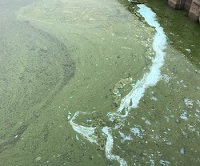Warning to Pet Owners and Watersports Enthusiasts After Blue-Green Algae Outbreaks Across Central Scotland
UNITED KINGDOM / AGILITYPR.NEWS / June 10, 2021 / Scientists are asking the public to look out for blue-green algae, which can be fatal for pets and harmful for people’s health. Also known as cyanobacteria, the toxic blooms have been found over the past few weeks across the Central Belt of Scotland – including Clackmannanshire, Falkirk, Midlothian, East Renfrewshire – and could appear in other water courses as a result of the recent warm, dry weather.
At the end of May, a dog died after coming into contact with suspected blue-green algae at Loch Awe and another became seriously ill after taking a drink from the River Fillan near Crianlarich.
Ecologists at the UK Centre for Ecology & Hydrology (UKCEH) are therefore asking the public to download their free Bloomin’ Algae app and report details of suspected outbreaks with a photograph. This will provide an early warning to other members of the public, thereby helping people and their pets, as well as watersports enthusiasts, to enjoy the natural environment safely.

Blue-green algae, pictured, can occur naturally in ponds, lakes, rivers, reservoirs and canals, and are toxic to anyone who swallows contaminated water or has skin contact with it.
The blooms have caused the deaths of dogs, horses, fish and other animals across the UK. People who come into contact with the algae, such as open water swimmers and canoeists, could suffer skin rashes, vomiting, diarrhoea, fever or muscle and joint pain.
The popular Bloomin’ Algae app was recently updated through funding from the Scottish Government to include a much-requested mapping feature and more rapid feedback to people reporting blooms.
Submitted records are immediately available to view on a map on the Bloomin’ Algae app. Experts will quickly verify them and inform the person who reported the sighting whether it appears to be blue-green algae or not. They will provide advice on whether outbreaks need to be reported to the landowner, who is responsible for ensuring warning signs are put up at a site. App users can also set up notifications of confirmed blooms in their area.
Professor Laurence Carvalho, a freshwater ecologist at UKCEH, who developed the app, says: “Blue-green algae tend to flourish in the UK from June to the autumn, during long spells of warm and dry weather. They are becoming more frequent due to climate change and the increasing amount of nutrients entering our waters, for example from sewage or fertilisers.
“By reporting blooms via the Bloomin’ Algae app, the public is providing a rapid, early warning about outbreaks and helping to give a comprehensive picture of these harmful blooms across Scotland. “
Thanks to app users, experts have this year been able to rapidly confirm blue-green algae outbreaks in several sites well visited by the public in Scotland including Threipmuir Reservoir in The Pentland Hills, Gladhouse Reservoir in Midlothian (both used by open water swimmers) and Balgray Reservoir in East Renfrewshire.
Professor Carvalho says blue-green algae can be confused with harmless blooms of blanketweed or duckweed [please see images in dropbox for comparisons]. Blue-green algae are often a vivid green colour, characteristically turning turquoise when they decay along the shoreline. Unlike blanketweed or duckweed, they do not look like lumpy clumps of hair or tiny leaves, and if you poke the blooms with a stick, they break up like a cloud of dust in the water.
Parents of young children are advised to keep them out of water where there is suspected blue-green algae, and dog walkers should keep their pets on a leash and wash their coats down as soon as possible if they go into contaminated water. Anyone concerned that they or their pets have been in contact with blue-green algae is advised to seek medical advice.
Dogs can become extremely ill within just a few minutes so owners should seek urgent veterinary assistance if their pets show symptoms such as diarrhoea, excessive drooling, muscle tremors and disorientation.
Download the Bloomin’ Algae app for free on Google Play and the App store. See the website for more details –ceh.ac.uk/bloomin-algae
About Us
UK Centre for Ecology & Hydrology (UKCEH)
The UK Centre for Ecology & Hydrology is a centre for excellence in environmental science across water, land and air. Our 500 scientists work to understand the environment, how it sustains life and the human impact on it – so that together, people and nature can prosper.
We have a long history of investigating, monitoring and modelling environmental change, and our science makes a positive difference in the world. The issues our science addresses include: air pollution, biodiversity, biosecurity, chemical risks, extreme weather events, droughts, floods, greenhouse gas emissions, land use, soil health, sustainable agriculture, sustainable ecosystems, sustainable macronutrient use, and water resources management.
The UK Centre for Ecology & Hydrology is a strategic delivery partner for the Natural Environment Research Council, part of UK Research and Innovation.
www.ceh.ac.uk / Twitter: @UK_CEH / LinkedIn: UK Centre for Ecology & Hydrology
Contacts